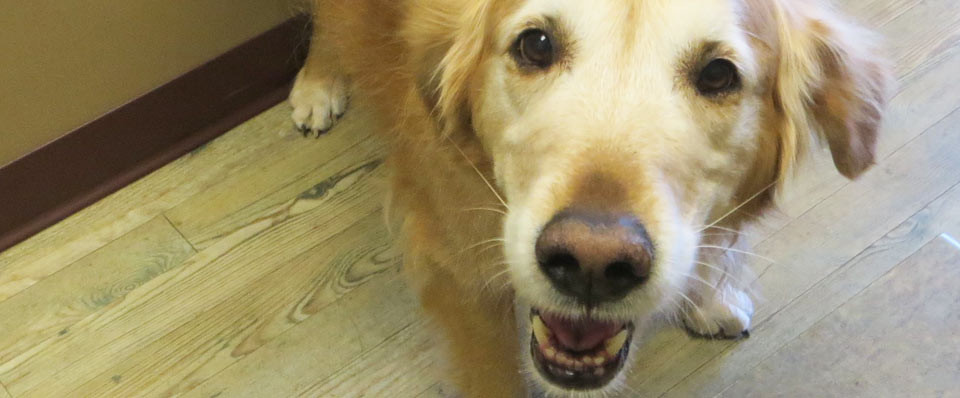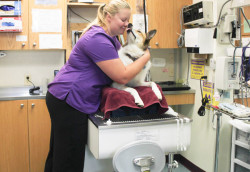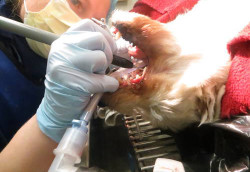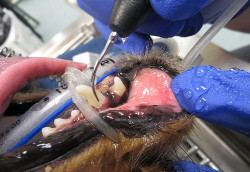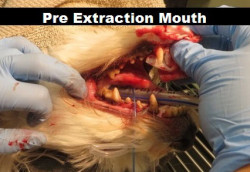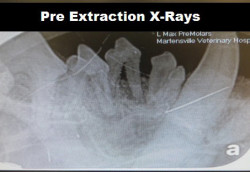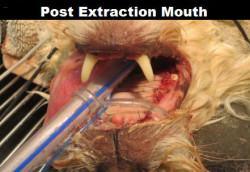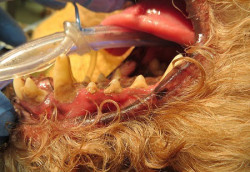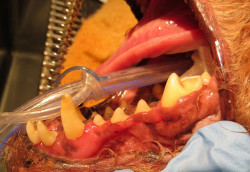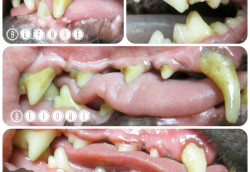Dentistry is important in pets too! Similar to humans, pets require routine dental care to remove plaque and tartar-forming bacteria from their teeth. While dental homecare, such as brushing, will significantly reduce the amount of bacteria in the mouth, professional dental services are often required.
Martensville Veterinary Hospital offers professional dental services that include comprehensive oral health assessments, digital dental x-rays, ultrasonic scaling, polishing, antibacterial rinses, dental sealants, and dental surgery (including tooth extractions).
Imagine what your mouth would feel like if you never brushed your teeth or went to the dentist!! According to the American Veterinary Dental Society, more than 80% of dogs and 70% of cats have dental disease by the age of 3. Dental (or periodontal) disease is the most frequently diagnosed health problem in pets. Often they do not show signs of obvious pain or discomfort, even with severe disease. It is common for clients to tell us that they didn’t notice a problem at all, but their pet seems years younger after their dental procedure!
We check your pet’s teeth at their wellness consultation, and offer a free dental check with a technician if you have any questions or concerns about your pet’s teeth at some other time. We can make an estimate for a Comprehensive Oral Health Assessment and Treatment (COHAT). At that time we can also help show you how to brush your pet’s teeth and recommend foods, treats and other homecare products that will help reduce gum inflammation, plaque and tartar buildup. There are lots of great and not so great products out there. Products with the VOHC seal have proven that they at least reduce plaque and/or tartar and many of them are available in grocery and pet stores.
Just like in people a thorough dental exam requires assessing each tooth with a probe and radiographs. Unlike people, we can’t tell cats and dogs to open, close, rinse or spit!! So they need to be under general anesthesia for a safe and pain-free experience. Check out our anesthesia section and read the dentistry procedure below if you would like more information. Ideally all pets would have a COHAT yearly throughout their adult years. Some pets with severe dental disorders need one every six months. Regular veterinary dental procedures, before an obvious problem occurs can help your pet keep most of their teeth and keep their mouth pain free, for life.
Bacteria and food debris accumulate around the teeth and, if left unchecked, can lead to deterioration of the soft tissue and bone surrounding the teeth. This decay can result in irreversible periodontal disease, tooth loss, jaw fractures, jaw bone infections, and expensive oral surgery. Some breeds and dogs with crowded or rotated teeth are more likely to have food accumulate and cause these problems. There is also some evidence to suggest that bacteria from an infected mouth can spread to the heart and form an infected mass (bacterial endocarditis). With every heartbeat, the blood is showered with bacteria and the bacteria can land and cause an abscess or infection anywhere in your pet’s body. This is a serious condition requiring extensive diagnostics and hospitalization and even with treatment, bacterial endocarditis may still be fatal.
OUR DENTISTRY PROCEDURE (COHAT):
- Once the patient is anesthetized, and hooked up to monitors a detailed oral examination is performed, much like your own dentist does. One by one the tooth surfaces are explored for damage (like wear, fractures and discoloration) and the teeth are probed between the teeth and gums looking for other abnormalities (like pockets of infection or root exposure). Findings are recorded on your pet’s dental record.
- Whole mouth intra-oral dental radiographs are done to assess the 60% or more of each tooth that is under the gumline as well as the surrounding bone. This also helps us find unusually shaped teeth, teeth that never erupted, abscesses at the root of the tooth, and determine the significance of wear or fractures seen above the gumline.
- The mouth is rinsed with an antibacterial solution.
- A treatment plan is made by the veterinarian based on the examination and radiographic findings. If there are extractions, the appropriate dental blocks are done at this time.
- Teeth are scaled above and below the gum line with an ultrasonic scaler and also by hand. Any pockets of infection between the crown and gumline are removed and flushed.
- If extractions are required, they are done at this stage using specialized dental equipment including a high speed dental drill and hand equipment like elevators and luxators. Each site is radiographed again to ensure that no root pieces are left behind, then the site is cleaned, smoothed, packed with a material to provide the building blocks for bone growth and sutured closed.
- The remaining teeth are polished above and below the gum line. This smooths the surface of the tooth, preventing early accumulation of plaque and tartar.
- The oral cavity and gingival sulci (area of the gums that surrounds the teeth) are flushed with water and antibacterial solution to remove any remaining debris.





